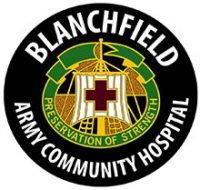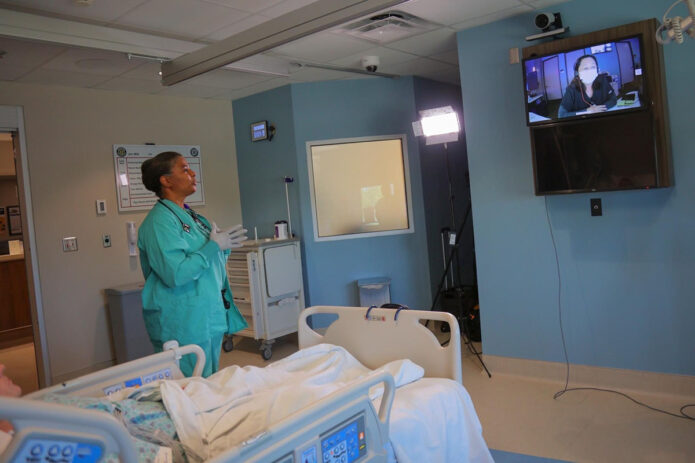 Fort Campbell, KY – Blanchfield Army Community Hospital (BACH) is the latest military treatment facility in the Military Health System to join the Defense Health Agency’s Joint Tele-Critical Care Network.
Fort Campbell, KY – Blanchfield Army Community Hospital (BACH) is the latest military treatment facility in the Military Health System to join the Defense Health Agency’s Joint Tele-Critical Care Network.
The JTCCN virtually integrates 24/7 access to highly skilled critical care physicians, or intensivists, from DHA medical centers, or “hubs”, like Naval Medical Center San Diego and Brook Army Medical Center, with “satellite” intensive care units at nearly 20 military treatment facilities worldwide.
“We want to make sure, as we care for the nearly 70,000 beneficiaries in the Army’s third largest active-duty population here at Fort Campbell, that we keep patients here at BACH versus sending them out to our network partners when possible. Our patients don’t want to travel if they don’t have too,” said Col. Vincent B. Myers, Blanchfield’s commander. “This capability only adds to the high level of safe quality care provided by ICU staff. Without Naval Medical Center San Diego and the Virtual Medical Operations Center, we could not provide this high-acuity service.”
Prior to joining the JTCCN, some critically ill patients at Blanchfield were transferred to network facilities frequently more than 50 miles and over an hour’s drive away if an intensivist was unavailable. BACH currently has two active-duty intensivists on staff, but if either position is vacant or gapped, or the provider is on leave, TDY or deployed, the JTCCN could provide additional support.
“Having JTCCN on-board provides enduring access to 24/7 critical care support to our hospitalists and ICU staff, providing an extra level of coverage and confidence to better support our service members, families, retirees, and future VA beneficiaries who trust BACH with their healthcare, said Blanchfield’s Deputy Commander for Clinical Services, Lt. Col. Ferdinand Bacomo, who is also a Medical Intensivist, experienced with JTCCN technology.

While stationed as an intensivist at Tripler Army Medical Center, Hawaii, from 2010-2014, Bacomo provided tele-critical consultation supporting military hospitals in Guam, Okinawa, Yokosuka, and South Korea.
“ICU care is a multi-disciplinary approach,” said Maj. Brenda Mitchell, a critical care nurse and head nurse at BACH’s ICU.
Mitchell explained that a critical care treatment team is composed of specially trained caregivers from different sections of the hospital, like nurses, dietitians, respiratory therapists, physical therapists, pharmacists, and physicians, who must work in consultation with one another and when necessary, an intensivist, to help critically ill patients recover.
“When the treatment team does bedside rounding with the patient, along with the Medical Officer of the Day and our intensivist, we collaborate with our virtual team at the bedside,” said Mitchell.
During a major renovation of Blanchfield’s 9,300 square foot ICU completed last year, JTCCN virtual health technologies were incorporated into each patient suite enabling the virtual teams to track and analyze vital signs, lab results, progress notes and other real-time data via secure network along with BACH staff. Cameras, microphones, and monitors installed in each ICU suite enable live consultations for staff from a patient’s bedside with a critical care provider from the network’s VMOC, as well as hubs.

“This really started with a fax machine between two MTFs many years ago and has blossomed into covering 18 sites and over 120 [ICU] beds across the DHA enterprise,” said U.S. Navy Cmdr. (Dr.) Jonas Carmichael, VMOC medical director, during a virtual teleconference with BACH stakeholders commemorating the hospital’s addition to the network.
“We really look forward to not just being able to be there to provide that competency, that medical decision-making capability for your unit and others when needed, but also to do what Colonel Myers discussed. To be the element that helps to leverage that MTF to keep our Soldiers, Sailors, and Marines on station with their units, with their family,” said Carmichael.
In addition to the benefits the JTCCN provides patients at BACH, it also serves to support ready medical Forces for the 101st Airborne Division (Air Assault), 531st Hospital Center and other Blanchfield partners, exposing their medical providers to greater, more complex, case mixes and technologies during their rotations at Blanchfield ARmy Community Hospital. It is possible that one day they may find the JTCCN down range to help deployed providers save the lives of their most critically ill patients.

“We just finished our semi-annual training brief with Medical Readiness Command, East, and one of the common themes throughout that dialogue was the fact that multiple medical platforms come to BACH for training, including Fort Knox, Redstone Arsenal, and others from the region. Blanchfield is truly a platform to support readiness,” said Myers.



